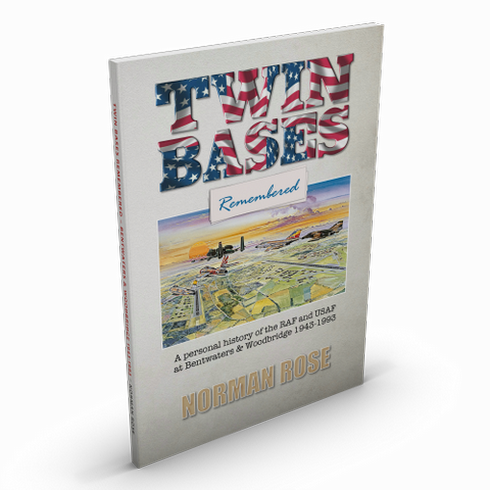051715 - TWIN BASES REMEMBERED: A Personal History of the RAF and USAF at Bentwaters and Woodbridge 1943-1993
By Norman Rose
NORMAN ROSE IS uniquely qualified to tell the story of the twin air force bases of Bentwaters and Woodbridge since he is one of the few people to have witnessed their entire history – from their construction during World War II to their final closure half a century later. Norman had been a spectator when the first aircraft arrived at the newly-constructed airfield in 1943 and was also present to witness the last USAF A10 Thunderbolt (piloted by Colonel Roger Radcliff) lift off the runway in 1993.
During the intervening years Norman had been employed on the Twin Bases in a variety of capacities for private contractors and the British Ministry of Defence and had been materially involved in the development of the original wartime bases into the impressive NATO twin-base complex they would eventually become during the Cold War years following the arrival of the USAF in 1951.
Norman grew up in the village of Iken near Woodbridge in Suffolk in the 1920s and 30s, when the local area was nothing but farmland and woodland but this changed in World War 2 when it was chosen as the site for two large airfields, RAF Sutton Heath and RAF Bentwaters. By then Norman was a teenager and managed to get a job working on the construction of Bentwaters. Little did he know at the time that this would remain his place of employment for the next 40 years.
The operational life of the wartime airfields proved to be short-lived. The war ended not long after their completion, although RAF Sutton Heath (later re-named Woodbridge) had saved the lives of many Allied airmen due to its FIDO fog-dispersal system and extra-wide runway, which enabled many battle-damaged aircraft to land safely when they might otherwise have crashed.
After the war the airfields were ‘mothballed’ until the arrival of the USAF 81st Fighter Bomber Wing in 1951. This marked the beginning of a new era for the bases under American control and would see them developed over the following 43 years and at the cost of many millions of dollars into a ‘Class A’ NATO airbase accommodating a nuclear-armed strike force. And, since Norman was there to witness it all, his reminiscences provide a unique insight into the history and development of the Twin Bases and the lives of the thousands of people, British and American, civilian and military, who lived and worked there during their 40+ operational years.
| Format | Softback |
| Pages | 162 |
| Publication Date | Available Now! |
| Pictures |
b/w and colour illustrations and photos throughout |
| Width (mm) | 205 |
| Height (mm) | 290 |
| Dust Jacket | No |
| ISBN | 978-1-846831-74-4 |
| Price |
£14.95 |


